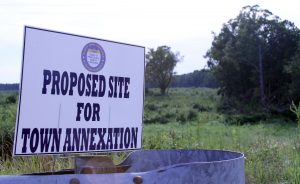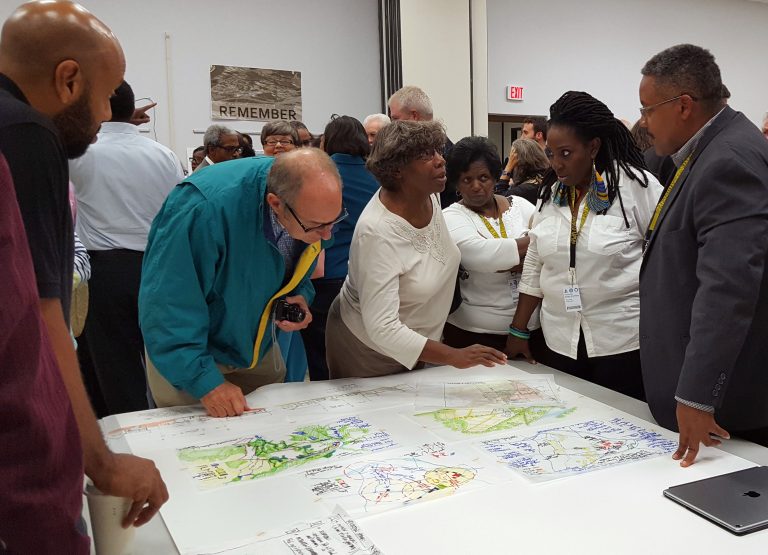
Loria Martin was lucky this last time. Her home in Southern Terrace, a Princeville, N.C. neighborhood, was spared the flooding that impacted so much of eastern North Carolina when Hurricane Matthew hit the state in early October 2016. She has been supporting family members but is thankful damage to her home was limited to a temporary loss of electricity.
When Hurricane Floyd hit the area 17 years earlier, she wasn’t as lucky.
“This time, I didn’t get hit, but in ’99 I lost almost everything,” Martin said.
Martin was among several hundred Princeville residents who attended a multi-day Community Design Workshop, held Aug. 25-29 in neighboring Tarboro, to design a plan for a more flood-resilient future. The event was co-sponsored by the town of Princeville, Edgecombe County, University of North Carolina at Chapel Hill’s (UNC-CH) Coastal Resilience Center of Excellence (CRC), North Carolina State University (NCSU) College of Design, North Carolina Emergency Management and the (N.C.) Governor’s Recovery Office.
This five-day workshop (see photos) brought together teams of land use planners, engineers, architects and landscape architects to collaborate with local, state and federal officials to develop three scenarios for a new 52-acre tract of land that the state intends to buy. The parcel will include houses, businesses, infrastructure, public facilities and community open space in ways that ensure that the new space connects physically, socially, environmentally and economically to historic portions of town. Located outside of the floodplain, the new space would make the town more resilient to future flooding.
The event was a unique collaboration between UNC-CH and NCSU. Faculty and students from the Department of City Regional Planning at UNC-CH, led by CRC Director Dr. Gavin Smith, joined forces with faculty and students from the NCSU College of Design for this effort.

The design team and resource team – which provided subject matter expertise for the design – included experts from across North Carolina and other states including Louisiana and New Jersey. Members came from organizations as varied as the North Carolina Sea Grant, U.S. Army Corps of Engineers and National Parks Service.
The workshop was part of a larger effort, the Hurricane Matthew Disaster Recovery and Resilience Initiative, which began earlier this year to address recovery and rebuilding issues in six communities: Princeville, Fair Bluff, Seven Springs, Windsor, Kinston and Lumberton. Since early 2017, a team led by CRC Director and UNC-Chapel Hill Professor Dr. Gavin Smith has met with leaders from the six communities to learn about the particular challenges the communities face.
A video about the event, produced in partnership with the North Carolina Rural Center, can be viewed on the Hurricane Matthew media page.
Princeville was formed in the waning days of the Civil War and incorporated in 1885. It is the first town founded by freed slaves in the United States. Though surrounded by a levee built in the 1960s, Princeville was affected by two storms less than 20 years apart that overtopped those defenses.
At the opening of the event, Princeville Mayor Pro Tem Linda Joyner said Hurricane Matthew “bullied us for 3 or 4 days” but now the town must focus on rebuilding for future generations. The town must make sure the magnitude of flooding from Hurricanes Matthew and Floyd (1999) do no happen again, Joyner said.
“Our youth will reap the benefits of what we’re doing here,” she said.
Focuses of the final designs, presented to residents on the final day of the workshop, included potential relocation of some residents, town services and businesses rebuilding some structures to make them more resilient. Designers also focused on reuse of land near the Tar River, making the area centered toward cultural and recreational purposes while avoiding structures that could flood in future storms.
Working together
Marshall Purnell, a Professor of the Practice at NCSU’s College of Design, said the effort to put all of the federal, state, local and university resources into one place to design a comprehensive plan for Princeville was impressive.
“This storm was devastating because Hurricane Floyd hit this community in 1999 – that was considered the ‘500-year event,’” Purnell said. “Seventeen years later, we got Matthew, which was not as intense as Floyd – maybe 85% of Floyd. When you have water in your house that is 6 feet as opposed to 8-9 feet, it doesn’t matter to you.”
The design team’s approach was to assess Princeville’s potential future in both the short and long term – 5 years from now and 50 years later, Purnell said. The team did not come with pre-set notions of what to design – that was instead driven by community feedback.
“Most people understand the significance of this town and they really want to remain here,” Purnell said. “Princeville has flooded many, many times since 1865. They don’t just want to pull up and leave, but they know they can’t stay and keep doing what they have been doing in the past.”
Having resources from UNC-CH and NCSU together, working to support a community, was a welcome sign, he said.
“It’s rewarding – it’s the kind of thing we as a profession, in academia, should be doing more of,” he said. “There’s no better way to learn than do it for real and for people who need it.”

Learning from history
Town Commissioner Milton Bullock said he was impressed by the attendance at the events.
“This is the closest Princeville has ever come to reconstructing itself and fulfilling the dream of our ancestors,” Bullock said. “We’re not moving Princeville, we’re expanding the footprint. At the same time, we have some issues to address, like the river.”
Eric Evans, Edgecombe County Manager, said displacement of residents from Hurricane Matthew is still a significant concern in the area. The town’s focus will be “building back better,” he said.
“The Tar River defines who you are as a town – flooding defines part of who you are,” Evans said. “It doesn’t have to define your destiny.”
State officials said that housing is still a concern in the 50 counties impacted by Hurricane Matthew – about half of those in North Carolina. Edgecombe County is among the four most affected by the storm, he said, and the focus is on making new and rebuilt structure more resilient.
Dan Brubaker of North Carolina Emergency Management said that floods from Hurricane Matthew rose more than 4 feet about the “500-year flood” gauges. A 500-year event is one that has a 0.2 percent chance of occurring in any given year, whereas a 100-year event has a 1 percent chance of happening in a given year.
More documents from the event can be found on the Princeville community engagement page.
Princeville resident Martin said she liked the ideas to use flood-prone property – a proposed Freedom Hill Walking Trail – for historical context and tourism income.
“We need recreation, something for the kids,” Martin said. “My concern was also with businesses and stores, which could bring revenue to Princeville. If we had our own stores we wouldn’t have to go so far.
“I’m feeling like the future of Princeville is looking pretty good. If everything that is said and done tonight follows through, we could be growing.”
